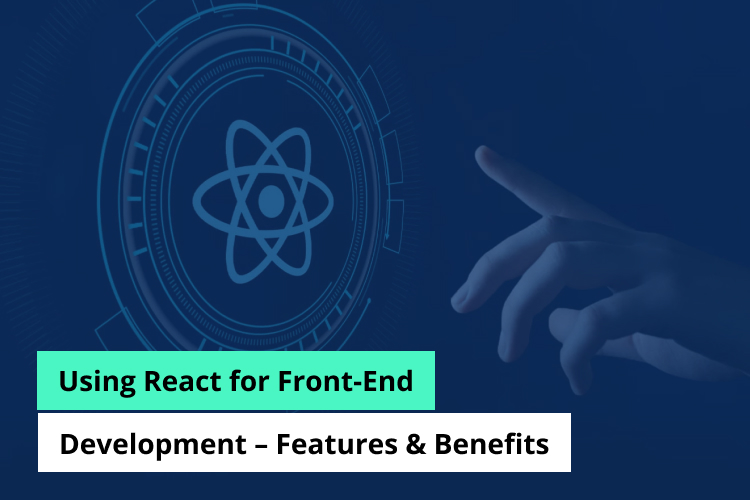AngularJS vs ReactJS vs VueJS: Which is Best for Your Business?

Are you facing the daunting task of choosing the perfect front-end technology for your business? Wondering which framework will best suit your needs and propel your projects toward success? Look no further! In this comprehensive blog, we aim to answer the burning question on every developer’s mind: AngularJS vs Top 3 Frontend Technologies: Which is Best for Your Business?
Frontend development has witnessed a rapid evolution, with an array of frameworks vying for attention and claiming to be the ultimate solution. However, navigating through the sea of options can be overwhelming, leaving you perplexed and uncertain about which path to take. But fear not, for we have undertaken the mission to demystify the selection process and provide you with valuable insights to make an informed decision.
Whether you are a startup looking to build a dynamic web application, an enterprise seeking scalability and performance, or a seasoned frontend developers aiming to stay updated with the latest trends, this blog is tailored for you. We delve into the strengths, weaknesses, and use cases of AngularJS, along with the top three front-end technologies that are currently dominating the landscape.
In this blog, we will compare the features, performance, community support, and suitability of each framework for your unique business requirements. By the end, you’ll have a clear understanding of which frontend technology aligns best with your goals, enabling you to embark on your development journey with confidence.
So, let’s dive in and explore the world of AngularJS, React, and Vue.js!
A Brief on AngularJS
AngularJS, developed by Google, revolutionized frontend development with its powerful features and two-way data binding. It introduced concepts like directives and dependency injection, making it an attractive choice for building dynamic web applications. However, with the release of Angular (also known as Angular 2+), AngularJS has taken a backseat. Here are the key considerations when evaluating AngularJS:
What are its Strengths?
- Comprehensive Framework: Angular is a complete and comprehensive framework that provides everything needed to build large-scale applications. It offers a wide range of features and tools, including robust data binding, powerful routing, form validation, dependency injection, and testing utilities. This comprehensive nature of Angular eliminates the need for developers to rely on external libraries or frameworks for essential functionalities.
- TypeScript Integration: Angular is built with TypeScript, a statically typed superset of JavaScript. TypeScript brings the benefits of strong typing, enhanced tooling, and better code organization to Angular applications. It helps catch errors at compile-time, provides improved code navigation and refactoring capabilities, and promotes maintainability and scalability.
- Enhanced Performance: Angular is designed to optimize performance, even in complex and highly dynamic applications. It utilizes a hierarchical dependency injection system, change detection mechanism, and Ahead-of-Time (AOT) compilation to deliver fast and efficient rendering. Angular’s change detection strategy, combined with a zone-based mechanism, reduces unnecessary DOM updates, resulting in improved performance.
- Reactive Programming with RxJS: Angular leverages the power of Reactive Extensions for JavaScript (RxJS) to handle asynchronous operations and event streams. RxJS provides a reactive programming paradigm, enabling developers to handle complex scenarios like asynchronous data streams, event handling, and state management in a more declarative and manageable way. It enhances code readability, simplifies handling of complex asynchronous flows, and improves application responsiveness.
- Component-Based Architecture: Angular follows a component-based architecture, where applications are built by composing reusable and self-contained components. Components encapsulate both the UI and the logic, promoting code reusability, modularity, and maintainability. Angular’s component-based approach makes it easier to manage complex UI structures and enables teams to work on different components simultaneously, enhancing collaboration and productivity.
- Angular CLI: Angular provides a powerful command-line interface (CLI) tool that streamlines the development process. The Angular CLI offers a set of commands for creating, building, testing, and deploying Angular applications. It automatically sets up project structure, generates boilerplate code, and handles various build and optimization tasks. The CLI accelerates development speed, enforces best practices, and simplifies project configuration.
- Strong Community and Ecosystem: Angular has a vibrant and active community, with extensive resources, documentation, tutorials, and community-driven libraries available. The community actively contributes to the framework’s development, providing timely updates, bug fixes, and new features. This strong community support ensures that Hire Angularjs Developers have access to a wealth of knowledge, assistance, and solutions to common challenges.
- Google Backing and Enterprise Support: Angular is developed and maintained by Google, a renowned technology company with extensive resources and industry expertise. This backing provides assurance of long-term support, continuous development, and updates. Angular is widely adopted by enterprises for building large-scale applications, and its enterprise-level features, such as server-side rendering, Angular Universal, and official support for accessibility, make it a solid choice for businesses with complex requirements.
What are its Weaknesses?
- Performance: AngularJS can be resource-intensive and may not be the most performant option for highly dynamic applications. Its two-way data binding mechanism can sometimes lead to performance bottlenecks.
- Steeper learning curve: Compared to some of the newer frontend technologies, AngularJS has a steeper learning curve due to its complex architecture and terminology. It may require more time and effort to become proficient in AngularJS development.
Read Our Blog : How Angularjs is transforming frontend development for businesses
A Brief on React
React, developed by Facebook, has gained immense popularity and is widely adopted by many industry giants. Known for its component-based architecture, React follows a unidirectional data flow, making it efficient and performant. Here’s what you need to know about React :
What are its Strengths?
- Component-Based Architecture: React follows a component-based architecture, where UIs are built by composing reusable and self-contained components. Components encapsulate both the UI and the logic, promoting code reusability, modularity, and maintainability. This modular approach makes it easier to manage complex UI structures, encourages code reusability, and enables teams to work on different components simultaneously, fostering collaboration and productivity.
- Virtual DOM and Efficient Rendering: React utilizes a virtual DOM, which is a lightweight representation of the actual DOM. By comparing the virtual DOM with the real DOM, React efficiently determines the minimum number of updates needed to synchronize the UI with the underlying data changes. This approach minimizes unnecessary re-rendering, resulting in improved performance and responsiveness of the application.
- Unidirectional Data Flow: React follows a unidirectional data flow pattern, also known as one-way data binding. Data flows in a single direction, from parent components to child components. This pattern simplifies the understanding and debugging of data changes, as data mutation is explicit and predictable. It also enables easier tracking of data flow and reduces the chance of data inconsistencies and bugs.
- JSX Syntax: React introduced JSX, a syntax extension that allows developers to write HTML-like code directly within JavaScript. JSX provides a declarative and intuitive way to define components, making the code more readable and maintainable. It combines the power of JavaScript and HTML, enabling developers to seamlessly integrate logic and UI within the same file.
- Virtual Community and Ecosystem: React has a large and vibrant community, with a vast ecosystem of libraries, tools, and resources available. The community actively contributes to the ReactJS development and creates a wealth of open-source projects, components, and tutorials. This active ecosystem provides developers with a wide range of options and solutions for common challenges, accelerating development speed and reducing the need to reinvent the wheel.
- React Native: React Native, built on top of React, enables developers to build cross-platform mobile applications using JavaScript. With React Native, developers can leverage their existing React skills to develop native-like mobile apps for both iOS and Android platforms. This allows for code sharing between web and mobile projects, saving time and effort while maintaining a consistent user experience across different platforms.
- Performance Optimization Tools: React offers various performance optimization tools and techniques to enhance the efficiency of applications. It provides features like memoization, shouldComponentUpdate, and React.lazy for lazy loading components, allowing developers to optimize rendering and improve application performance. Additionally, the React team regularly releases updates and optimizations to further improve React’s performance.
- Strong Industry Adoption: React has gained significant industry adoption, with many prominent companies using it for their web applications. This widespread adoption ensures the availability of skilled ReactJS developers, ample job opportunities, and ongoing support and updates from both the community and Facebook.
What are its Weaknesses?
- Boilerplate code: React’s simplicity comes at the cost of some additional setup and boilerplate code, especially when it comes to managing application state. Developers may need to rely on additional libraries like Redux or MobX to handle complex state management scenarios.
- The learning curve for beginners: React’s paradigm shift from traditional JavaScript can be challenging for developers who are new to the framework. Understanding concepts like JSX and component lifecycle methods requires some initial effort.
A Brief on Vue.js
Vue.js, often referred to as the progressive JavaScript framework, has rapidly gained popularity in recent years. Its simplicity, flexibility, and gradual learning curve make it a compelling choice for developers. Let’s explore Vue.js in more detail:
What are its Strengths?
- Approachable and Easy to Learn: Vue.js has a gentle learning curve, making it approachable for developers of varying skill levels. Its syntax is straightforward and intuitive, resembling HTML templates and JavaScript, which eases the onboarding process. Developers familiar with HTML, CSS, and JavaScript can quickly grasp the basics of Vue.js and start building applications.
- Versatile and Incremental Adoption: Vue.js is designed to be incrementally adoptable, meaning that you can introduce Vue.js into an existing project gradually. It can be integrated into small sections of an application or used to build an entire application from scratch. This versatility allows developers to leverage Vue.js’s benefits without requiring a full-scale rewrite of existing codebases, making it a practical choice for both new and existing projects.
- Component-Based Architecture: Vue.js follows a component-based architecture similar to React, where applications are composed of reusable and self-contained components. This promotes code reusability, modularity, and maintainability. Components in Vue.js encapsulate both the UI and the behavior, making it easier to manage and reason about complex user interfaces.
- Reactive and Efficient Rendering: Vue.js utilizes a reactive data-binding system that enables automatic and efficient UI updates. When data changes, only the affected components are re-rendered, thanks to Vue.js’s fine-grained dependency tracking. This approach minimizes unnecessary re-rendering and ensures optimal performance.
- Vue CLI and Devtools: Vue.js provides the Vue CLI, a powerful command-line interface that streamlines project setup and development workflows. It automates the project scaffolding, provides a development server, and offers features like hot module replacement for faster development iterations. Additionally, Vue.js offers browser devtools that aid in debugging, inspecting components, and analyzing performance, enhancing the developer experience.
- Flexibility and Scalability: Vue.js offers a flexible architecture that allows developers to adopt the best practices based on their project requirements. It supports a variety of development approaches, including template syntax, single-file components, and render functions. Vue.js can be used for small projects as well as large-scale applications, providing scalability as the project grows.
- Vue Router and Vuex: Vue.js provides official routing and state management solutions: Vue Router and Vuex, respectively. Vue Router allows developers to create single-page applications with client-side routing, enabling seamless navigation and dynamic loading of content. Vuex provides a centralized store for managing application state, making it easier to handle complex data flows and share data between components.
- Active and Supportive Community: Vue.js has a rapidly growing community that actively contributes to its development and offers extensive resources, documentation, and community-driven libraries. The community-driven ecosystem provides access to a wide range of plugins, components, and tools that further enhance VueJS development.
What are its Weaknesses?
- Smaller ecosystem: Although Vue.js has a growing ecosystem, it may not be as extensive as React or Angular. This can make it slightly more challenging to find specific libraries or resources for certain niche use cases.
- Maturity: While Vue.js is gaining popularity, it may not have the same level of maturity or enterprise adoption as React or Angular, which could raise concerns for businesses requiring long-term support and stability.
Choosing the Best Framework for Your Business 
Choosing the best framework for your business is a critical decision that can significantly impact the success of your frontend development projects. With a multitude of options available, it’s important to carefully evaluate the strengths and suitability of each framework based on your business requirements. Here are some factors to consider when choosing the best framework for your business:
- Project Requirements: Start by assessing the specific requirements of your project. Consider factors such as the complexity of the application, expected user base, scalability needs, performance requirements, integration with backend systems, and available development resources. Understanding your project requirements will help narrow down the choices and identify frameworks that align with your needs.
- Learning Curve and Developer Skillset: Evaluate the learning curve associated with each framework and the existing skillset of your development team. Consider the familiarity of your team with the chosen framework and its ecosystem. If your team has expertise or prior experience with a particular framework, it can accelerate the development process and reduce the learning curve. However, be open to exploring new frameworks if they better match your project requirements.
- Community Support and Ecosystem: Assess the strength and activity of the framework’s community. A vibrant community ensures ongoing development, regular updates, bug fixes, and a wide range of resources, libraries, and plugins. A strong ecosystem provides access to tools, integrations, and community-driven components that can accelerate development and resolve common challenges.
- Performance and Scalability: Consider the performance characteristics of the frameworks under consideration. Assess their ability to handle large-scale applications, heavy traffic, and complex data flows. Look for features like efficient rendering, caching mechanisms, and optimization tools that can enhance performance. Evaluate whether the framework can scale alongside your business and accommodate future growth.
- Documentation and Support: Evaluate the quality and comprehensiveness of the framework’s documentation. Well-documented frameworks make it easier for developers to understand and utilize the features effectively. Additionally, consider the availability of official support, forums, and active communities where you can seek assistance and share knowledge.
- Integration with Existing Tools and Technologies: Assess how well the framework integrates with your existing tech stack, including backend systems, databases, and other tools. Compatibility with existing technologies can streamline development and reduce potential roadblocks. Consider frameworks that provide seamless integration options or have existing plugins and libraries that support your required integrations.
- Long-Term Viability and Updates: Consider the long-term viability of the framework and its roadmap. Look for frameworks that are actively maintained, have a consistent release cycle, and demonstrate a commitment to ongoing Angularjs development Services. Frameworks with long-term support and regular updates ensure compatibility with new browser versions, security patches, and evolving web standards.
- Cost and Licensing: Evaluate the cost implications of using a particular framework. While many frameworks are open-source and free to use, some may have licensing fees or commercial support options. Consider your budget and the potential return on investment when assessing the cost of adopting a specific framework.
- Case Studies and Industry Adoption: Research case studies and examples of successful projects that have utilized the frameworks you are considering. Analyze how these frameworks have been used in real-world scenarios and their impact on business outcomes. Consider frameworks that have gained industry adoption and are used by reputable organizations, as it can provide assurance of stability, reliability, and ongoing support. By carefully considering these factors, you can make an informed decision and choose the best framework for your business. Remember that the optimal framework choice may vary based on the specific needs of each project, so it’s essential to evaluate each project individually and adapt accordingly. Regularly reassess your framework choice as technology evolves and your business requirements evolve over time.
Wrapping it Up
AngularJS, React, Vue.js, and Angular all have their unique features and use cases. AngularJS, with its robustness and two-way data binding, may still be suitable for certain projects. React’s component-based architecture and performance make it a popular choice, while Vue.js’s simplicity and versatility make it an appealing option for many developers. Angular, the successor to AngularJS, provides a comprehensive framework for large-scale applications. Carefully evaluate your project’s needs and weigh the strengths and weaknesses of each framework to make an informed decision that aligns with your business goals and sets you up for long-term success.
We’re honored to mention that our efforts have been recognized by renowned B2B review and research platforms such as GoodFirms, Clutch, MirrorView, and many more.
Want more information about our services?
Similar Posts

Using React for Front-End Development – Features & Benefits
In today’s fast-paced world, where technology is constantly evolving, companies need to stay up-to-date with the latest trends and tools. You don’t want to be that company using a fax machine in 2023, do you? That’s just embarrassing. When it comes to front-end development, React is the cool kid on the block. It’s the leather […]...

Top 3 WordPress Development Tools
WordPress developers do most of their work in test environments. If you are a WordPress developer or a company offering WordPress development services, you need an excellent WordPress development tool....

Why NodeJS is the Perfect Choice for Building Scalable and High-Performance Applications
Are you looking to build high-performance and scalable applications that can handle real-time communication and heavy traffic? If so, Node.js might be the answer you’ve been searching for. In today’s digital era, where speed and responsiveness are paramount, traditional server-side technologies often struggle to keep up with the demands of modern applications. But fear not, […]...






